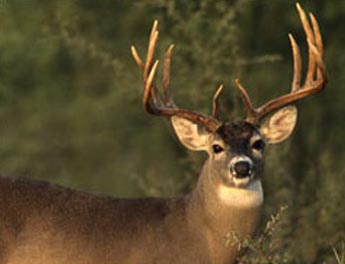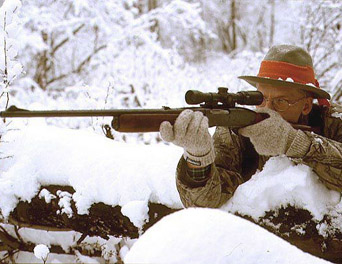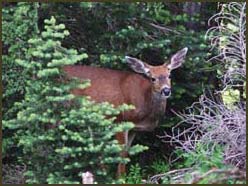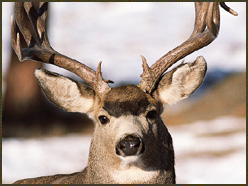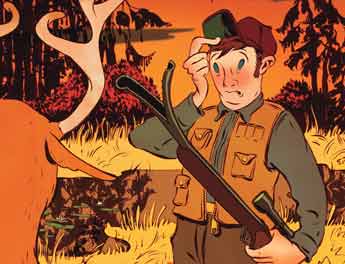The racks went from wall to wall, with photos splattered between, all showcasing a different behemoth buck next to the same gleeful hunter. “So what’s this guy’s story?” said my buddy, staring at the sight. “Did he take out a second mortgage on his home and start a night job so he could fill his Rolodex with the best outfitters money can buy?”
Then, looking closer, he said, “Wait a second. His back porch is in every one of these photos — there’s no Texas scrub or Alberta grainfield here. This is the East Coast. Is this guy stealing these deer from a local game pen?”
As if on cue, Rick Payne, owner of the cheesy grin beaming from every photo, strode in and proclaimed, “I tagged all of those boys out back.”
At that my friend’s mouth went from a gawk to a clenched lip of doubt, and Rick saw he’d have to divulge his secret or be thought a liar. “I bagged all of these deer from a few local woodlots,” he explained. “In fact, the majority of them came from one 60-acre section. There may not be as many eye-popping bucks in suburban or semi-rural America as there are, say, on a managed Texas ranch, but they are out there. You just have to know how to find them.”
With that, he began to spill what he knew, starting with the fact that there are three basic sizes of cover around most Eastern, Midwestern and Southern towns and cities that can hold a mature whitetail. Then he spelled out how to find and hunt a big buck in each area. Here’s what he said.
**
Woodlots
**Woodlots–home or building lots of 5 to 25 acres–harbor some of the highest whitetail populations anywhere (some areas in the U.S. have more than 75 deer per square mile). But you should stay away from areas that are overpopulated with deer, because biologists say that you’ll find the healthiest bucks with the biggest racks in areas with fewer than 30 deer per square mile.
The best lots offer a diverse set of habitats. Look for sites that are mostly hardwoods with a few thickets, some pines or cedars and maybe a creek or pond. And stay clear of heavily hunted areas. The ideal location will be unpressured due to rough terrain or because it’s so small that it’s overlooked. Many of these areas will be daytime sanctuaries, so tread lightly and go in only when the wind is right. Lastly, don’t waste your time with an area if you don’t find big buck sign there.
** Buck Behavior **
Woodlot whitetails are used to barking dogs, screaming children and vehicles zooming by, but the deer are still wild.
If you spot a buck and drive by, he’ll probably just stand there. Make a move toward him, however, and he’ll run. A buck’s home range may encompass 25 to 100 of these 5- to 25-acre lots. Your job is to pin down when and where he’s feeding, bedding or passing through the lot you’re hunting.
** Scouting Tips **
Since lots are small, forget about trying to find and decipher rub lines. Just look for clusters of rubbed saplings on a little oak ridge or flat. Deep, splayed, three-inch tracks seal the deal that a buck or two are feeding there.
Look inside a lot for a half-acre swamp, a ridge thicket or a weedy ditch — it doesn’t take much cover to hide a big buck. Check bedding sites for big tracks and droppings, and jump for joy if you find one or two rubs as thick as your biceps.
Scout for trails that link acorns and thickets. And note “freeway trails” that simply cut through a lot. You’ll find many deer runs on the sides of ridges and in hollows and creek bottoms.
** Tactics **
You’ve got to slip into a lot without blowing deer out. Be smart and devise a plan. Suppose there’s a huge thicket three-quarters of a mile north of a cornfield. Okay, on afternoons after work, play the wind and sneak into the spot from either the east or the wt side, depending on the wind. In this way you won’t bump deer coming to the lot from their bedding area.
In November, watch deer trails that cut through lots. Bucks run them to scent-check for does in estrus. When archery hunting in a town or suburb, play the wind and hang a stand 25 yards off a run. If it’s legal and safe to hunt with a gun, back off a trail 60 yards or so and try to set up where you can cover two or more runs.
**
Timber Blocks **
In rural areas and suburbs 40 miles or so outside cities, 50- to 150-acre blocks of woods dotted with thickets are great places to hunt. They are small enough to concentrate and funnel whitetails, yet large enough for you to set up stands at a bunch of different locations. This makes it easy to switch stands when the wind changes. Try to pick a block that deer will travel through from a food source to a bedding area. Many of these linear “strips” of forest connect crop fields, pastures, swamps and larger woodlands.
** Buck Behavior **
Blocks are larger than the lots we just talked about, so deer spend more time in them, munching on acorns, browsing and loafing in thickets. Still, a block may be only one-quarter of a buck’s home range, so you need to find out when he’s using that area.
** Scouting Tips **
Scout a block by checking for falling acorns and bedding areas that are covered with rubs. You might find a rub line that leads from a thicket to an oak tree to a crop field that borders the timber.
** Tactics **
Since deer move into and out of blocks all the time, coming and going and cutting across, funnel stands are most productive in the morning and evening. Set a few tree stands to overlook hollows, ridge points and crossings. A mature buck walks down funnels and around points, especially funnels that are rimmed with thick cover. Move from stand to stand every few days to minimize your scent and presence in an area.
When the rut erupts, a dominant buck will be on the move. You might spot him chasing a doe across a pasture two miles away. But hang tight as long as you’re seeing does. While he’s gone, another 8- or 10-pointer might cruise past one of your stands, hot after those untended does. And there’s a good chance the big boy you really want will circle back into his core area.
**
Small Farms**
Crops, clover pastures, thickets, woodlots and maybe a creekäI’d say that many, if not most, of the record-book whitetails killed today — especially Pope-and-Young-size bucks — come off farms with about 200 to 500 acres of mixed habitat. Once a symbol of rural America, many farms now sit on the sprawling outskirts of suburbia.
** Buck Behavior **
What more could a buck want? He has food, cover and does. If hunting pressure is light, a buck will live year-round on a farm.
Such deer are accustomed to seeing and hearing trucks, and they’re used to people. As they do in all checkerboard habitats, old bucks become masters of deception by hiding in thickets and moving a lot at night.
** Scouting Tips**
On September evenings, glass the edges of a corn, wheat or bean field for a trophy coming to feed and showboat for does. Study where the big guy comes out of the surrounding woods. Also, cruise the edges of the field in the middle of the day and look for his trail or rub line.
** Tactics **
First, try hanging your tree stand where you’ve seen the buck enter a field or found his sign. This works well before the rut, because the buck is still in a predictable bed-to-feed pattern. If you don’t get him by the time blackpowder or modern-gun season rolls around, you’ll probably have to head back into the bordering trees.
Sneak into the woods and look for big rubs and tracks. Just don’t spend too much time in there, because your scent will only make him move to another area. You know the buck is close by, but where? Well, a perimeter thicket on a ridge a half-mile or so from a crop field is a good bet. The buck may bed there. Or he might stage in the cover before hitting the field after dark.
Now check the edges of a good-looking thicket for big rubs, scrapes and tracks. Acorns will help to hold does and the rutting buck in the area. Look for a nearby hollow, saddle or similar funnel pocked with sign. Play the wind and set a stand, like I did a couple of years ago.
One November morning I spotted a deer, fat as a steer, tipping up out of a beaver swamp, sneaking through honeysuckle toward my ridge post. I’d know those antlers anywhere. I’d seen the nine-pointer three times from my field stands back in archery season. Boom! I dropped him with my muzzleloader. I couldn’t claim his 140-inch rack for the book, but so what? He was a cool trophy — a homeboy that I tagged less than 20 miles from my house in Virginia.
Sneak into the woods and look for big rubs and tracks. Just don’t spend too much time in there, because your scent will only make him move to another area. You know the buck is close by, but where? Well, a perimeter thicket on a ridge a half-mile or so from a crop field is a good bet. The buck may bed there. Or he might stage in the cover before hitting the field after dark.
Now check the edges of a good-looking thicket for big rubs, scrapes and tracks. Acorns will help to hold does and the rutting buck in the area. Look for a nearby hollow, saddle or similar funnel pocked with sign. Play the wind and set a stand, like I did a couple of years ago.
One November morning I spotted a deer, fat as a steer, tipping up out of a beaver swamp, sneaking through honeysuckle toward my ridge post. I’d know those antlers anywhere. I’d seen the nine-pointer three times from my field stands back in archery season. Boom! I dropped him with my muzzleloader. I couldn’t claim his 140-inch rack for the book, but so what? He was a cool trophy — a homeboy that I tagged less than 20 miles from my house in Virginia.

